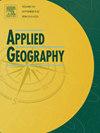Top-down versus bottom-up: Spatial pattern and human mobility of newly developing industrial towns in Chinese “city-NIT” network
IF 5.4
2区 地球科学
Q1 GEOGRAPHY
引用次数: 0
Abstract
In recent decades, during Chinas rapid urbanization and industrial transformation, newly-developing industrial towns (NITs) have emerged at the interface between cities and rural areas in China. Among them, characteristic towns (Tese Xiaozhen) and Taobao towns exemplify top-down and bottom-up development pathways, respectively. These emerging towns may become critical nodes in China’s evolving urban–rural system and present opportunities for modeling human mobility. This study focuses on the spatial patterns, human mobility, and their network features of NITs within China’s urban system. Specifically, we analyzed the spatial distribution of NITs and their geographic linkages with major cities. Under hypothetical short-term mobility scenarios, interconnections within the “city–NIT” system were simulated using both the radiation model and the gravity model, followed by a comparative analysis of the two approaches. Furthermore, the radiation model outputs were used to construct a directed city–NIT network, which was subsequently evaluated using complex network indicators. Results indicated significant differences in spatial distribution between characteristic towns and Taobao towns, with the latter prominently concentrated in coastal areas. Despite differences in model assumptions, results from both models showed strong positive correlations across spatial scales, with radiation model estimates exhibiting greater regional stability. From a directed network perspective, NITs channeled short-term mobility flows, shaping sub-networks anchored by major metropolitan areas. This underscores the ongoing redefinition of China’s urban system, in which smaller nodes are capable of attracting or catalyzing short-term population movements. These findings suggest differences in adaptability between the two primary human mobility models. The findings may inform optimal planning for short-term human mobility to NITs and deepen understanding of the spatial organization and hierarchical characteristics of China’s urban system. Further, the proposed framework offers a reference for integrating emerging towns in other developing countries into existing urban systems.
自上而下与自下而上:中国“城市- nit”网络中新发展工业城镇的空间格局与人口流动性
近几十年来,在中国快速城市化和产业转型的过程中,新兴的工业城镇(NITs)在中国城乡结合部出现。其中,特色小镇(色小镇)和淘宝小镇分别体现了自上而下和自下而上的发展路径。这些新兴城镇可能成为中国不断发展的城乡体系的关键节点,并为模拟人类流动提供了机会。本文主要研究了中国城市体系中新城市的空间格局、人口流动性及其网络特征。具体而言,我们分析了nit的空间分布及其与主要城市的地理联系。在假设的短期交通情景下,采用辐射模型和重力模型模拟了“城市- nit”系统内部的相互联系,并对两种方法进行了比较分析。此外,利用辐射模型的输出构建了一个定向城市- nit网络,随后使用复杂网络指标对其进行了评估。结果表明:特色小镇与淘宝小镇在空间分布上存在显著差异,淘宝小镇主要集中在沿海地区;尽管模式假设存在差异,但两种模式的结果在空间尺度上显示出很强的正相关性,辐射模式估计值表现出更大的区域稳定性。从定向网络的角度来看,nit引导了短期移动流量,形成了以大城市为基础的子网络。这凸显了中国城市系统正在进行的重新定义,其中较小的节点能够吸引或催化短期人口流动。这些发现表明,两种主要人类活动模式之间的适应性存在差异。研究结果可为短期人口流动的优化规划提供参考,并加深对中国城市体系空间组织和层次特征的理解。此外,所提出的框架为其他发展中国家的新兴城镇融入现有城市体系提供了参考。
本文章由计算机程序翻译,如有差异,请以英文原文为准。
求助全文
约1分钟内获得全文
求助全文
来源期刊

Applied Geography
GEOGRAPHY-
CiteScore
8.00
自引率
2.00%
发文量
134
期刊介绍:
Applied Geography is a journal devoted to the publication of research which utilizes geographic approaches (human, physical, nature-society and GIScience) to resolve human problems that have a spatial dimension. These problems may be related to the assessment, management and allocation of the world physical and/or human resources. The underlying rationale of the journal is that only through a clear understanding of the relevant societal, physical, and coupled natural-humans systems can we resolve such problems. Papers are invited on any theme involving the application of geographical theory and methodology in the resolution of human problems.
 求助内容:
求助内容: 应助结果提醒方式:
应助结果提醒方式:


